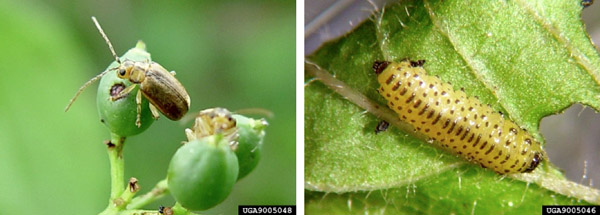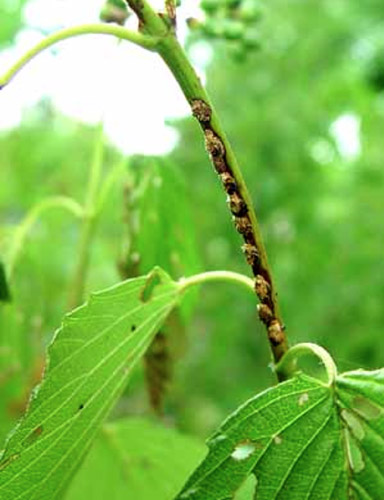Issue 9, June 18, 2010
Viburnum Leaf Beetle: Garden Menace

Photos courtesy of Invasive.org
Viburnum is one of America's most popular shrubs because of its beautiful flowers and wildlife attracting berries. However, this pretty plant is being threatened by the invasive viburnum leaf beetle (Pyrrhalta viburni), a native of Europe that has been moved to North America on infected viburnums. The adult beetle is small, 1/4 to 3/8 of an inch long and is a golden brown color with a sheen when in sunlight. The larvae are greenish- yellow and develop dark spots as they age.
Both larvae and adults feed heavily on viburnum plants. Adults lay eggs in new growth of the plant. When the larvae hatch, they begin to skeletonize the leaves, often leaving only the midribs and major veins. The larvae migrate to the soil to pupate. When they emerge as adults, the viburnum leaf beetle continues to defoliate the plant by chewing irregular, circular holes.
The viburnum leaf beetle can be easily detected. Look for defoliated plants as well as larval exit holes (pictured below, photo courtesy of Cornell University). If you discover the viburnum leaf beetle in your garden, there is still hope. The simplest and most effective method of treatment is to remove the infected twigs (pictured below). They will be leafless, with scars on the underside and can be found between early October and mid April. Another option is to encourage beneficial insects that feed on the viburnum leaf beetle, such as lady beetles, lacewings and spined soldier bugs. This can be done by having a diverse array of plants and avoiding broad spectrum insecticides, using organic options instead. The viburnum leaf beetle can also be stopped if Tanglefoot, a sticky pest barrier, is placed around the base of the plant. This prevents the larvae from moving down the stem to pupate, effectively stopping the cycle.

Photo courtesy of Cornell University
The viburnum leaf beetle was identified for the first time in Illinois in 2009. If you see this pest or have questions, please contact the Illinois Cooperative Agricultural Pest Survey (CAPS).--Stephanie McLaughlin